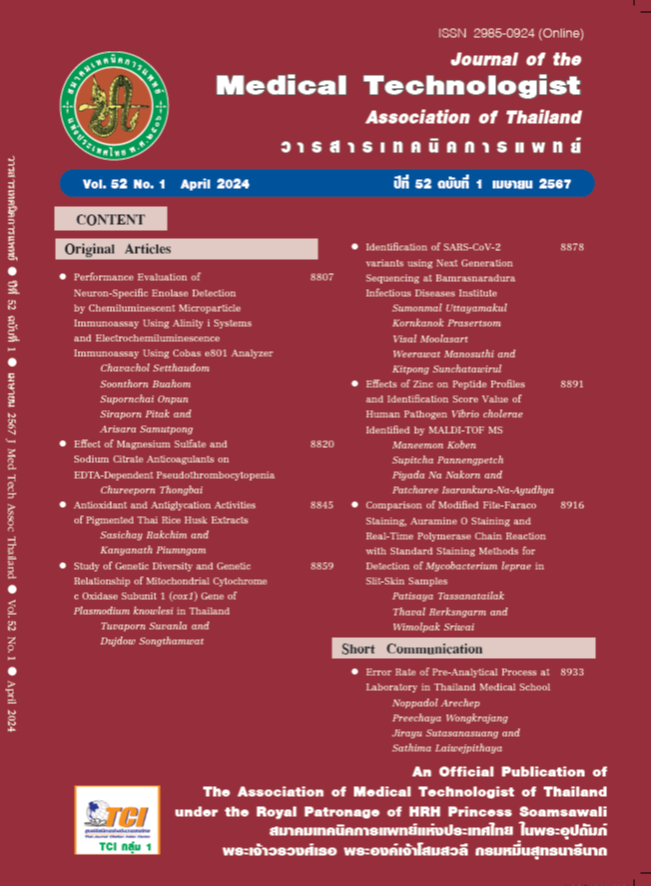Study of Genetic Diversity and Genetic Relationship of Mitochondrial Cytochrome c Oxidase Subunit 1 (cox1) Gene of Plasmodium knowlesi in Thailand
Keywords:
Cluster, Cox1, Maximum Parsimony (MP), Phylogenetic tree, P. knowlesiAbstract
Malaria affects 40% of people worldwide. Plasmodium knowlesi is found in Macaca fascicularis in Southeast Asian countries and can be transmitted to humans. Cytochrome c oxidase subunit 1 gene (cox1) is an important mitochondrial DNA encoding important protein subunits in the cellular respiratory process. Cox1 is commonly used to identify species and study the evolution of living beings. The objective of this research is to study of genetic diversity and genetic relationship of Mitochondrial cox1 gene of Plasmodium knowlesi in Thailand. In this research, forty DNA samples were collected from 11 provinces in Thailand and confirmed as P. knowlesi. Cox1 gene was used as the DNA target for amplification by PCR. The phylogenetic tree was constructed from nucleotides sequence data of cox1 gene to classify P. knowlesi cluster in Thailand by using the Maximum Parsimony method. The correlations between clusters and patient data, residential area, and parasite density were analyzed. The results showed that the phylogenetic tree can divide P. knowlesi into 13 clusters (Cluster I-XIII). Cluster I (8 isolates), Cluster II (7 isolates), Cluster III (3 isolates), Cluster IV (1 isolate), Cluster V (4 isolates), Cluster VI (1 isolate), Cluster VII (3 isolates), Cluster VIII (1 isolate), Cluster IX (1 isolate), Cluster X (3 isolates), Cluster XI (2 isolates), Cluster XII (1 isolate), and Cluster XIII (5 isolates). There were more males infected with P. knowlesi (35 males) than females (5 females). The age group infected with P. knowlesi < 40 years old was 15 persons and age group ≥ 40 years old was 25 persons. Thirty-nine persons are Thai and 1 person is Myanmar. Twenty-six patients from 33 patients have parasite density < 10,000 /μL of blood and 7 patients have parasite density ≥ 10,000 /μL of blood. In conclusion, P. knowlesi were divided into 13 clusters. The parasites in the same clusters are similar in genetics and most isolates in different areas have different nucleotide sequences. This research is preliminary data of molecular epidemiology of P. knowlesi in Thailand. This data can be applied in public health and planning for malaria control and malaria eradication in Thailand.
References
World Health Organization. Guidelines for the treatment of malaria. 3rd ed. Italy: World Health Organization; 2012.
World Health Organization. Management of severe malaria: a practical handbook. 3rd ed. Geneva: World Health Organization; 2012.
Putaporntip C, Hongsrimuang T, Seetham- chai S, et al. Differential prevalence of Plasmodium infections and cryptic Plasmodium knowlesi malaria in humans in Thailand. J Infect Dis 2009; 199: 1143-50.
Sermwittayawong N, Singh B, Nishibuchi M, Sawangjaroen N, Vuddhakul V. Human Plasmodium knowlesi infection in Ranong province, southwestern border of Thailand. Malar J 2012; 11: 36.
Lertprom R, Kanchanasuwan J, Ketkaew J, et al. The first Plasmodium knowlesi, Saraburi Province. June 2017. WESR Wkly Epidemiol Surv Rep 2017; 48: 801-8.
Fong MY, Lau YL, Chin LC, Al-Mekhlafi AM. Sequence analysis on the mitochondrial cox1 gene of recent clinical isolates of Plasmodium knowlesi in Klang valley, peninsular Malaysia. Trop Biomed 2011; 28: 457-63.
Loh JP, Gao QH, Lee VJ, Tetteh K, Drakeley C. Utility of cox1 phylogenetics to differentiate between locally acquired and imported Plasmodium knowlesi infections in Singapore. Singapore Med J 2016; 57: 686.
De JA, Kadir KA, Mohamad DS, et al. New vectors in northern Sarawak, Malaysian Borneo, for the zoonotic malaria parasite, Plasmodium knowlesi. Parasit Vectors 2020; 13: 472.
Kumbancha Y, Jirapornku C, Tungsrithong N. Factors in association with malaria infection in Phu Phan district, Sakon Nakhon province, Thailand. KKU Journal for Public Health Research 2015; 8: 57-64.
Chaveepojkamjorn W, Pichainarong N. Malaria infection among the migrant population along the Thai-myanmar border area. Southeast Asian J Trop Med Public Health 2004; 35: 48-52.
Pongsiri K. Factors related to malaria infection among people in border communities in Mae Sariang district, Mae Hong Son province. Dis Control J 2021; 47: 678-86.
Srichuen R. Risk factors of malaria infection in Thai-Myanmar border Ranong Province, Thailand (dissertation). Khon Kaen: Khon Kaen University; 2005. 125 p.
Sermwittayawong N, Singh B, Nishibuchi M, Sawangjaroen N, Vuddhakul V. Human Plasmodium knowlesi infection in Ranong province, southwestern border of Thailand. Malar J 2012; 11: 36.
Jongwutiwes S, Buppan P, Kosuvin R, et al. Plasmodium knowlesi malaria in humans and macaques, Thailand. Emerg Infect Dis 2011; 17: 1799.
Sugaram R, Boondej P, Srisutham S, et al. Genetic population of Plasmodium knowlesi during pre-malaria elimination in Thailand. Malaria J 2021; 20: 1-8.
Ngernna S, Rachaphaew N, Thammapalo S, Prikchoo P, Kaewnah O, Manopwisedjaroen K. Case report: case series of human Plasmodium knowlesi infection on the Southern border of Thailand. Am J Trop Med Hyg 2019; 101: 1397-401.
Phillips RE, Looareesuwan S, Warrell DA, et al. The importance of anemia in cerebral and uncomplicated falciparum malaria: role of complications, dyserythropoiesis and iron sequestration. Q J Med 1986; 58: 305-23.
Downloads
Published
How to Cite
Issue
Section
License
Copyright (c) 2024 Journal of the Medical Technologist Association of Thailand

This work is licensed under a Creative Commons Attribution-NonCommercial-NoDerivatives 4.0 International License.






